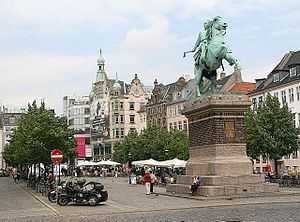Højbro Plads

Højbro Plads (English: Højbro Square) is a rectangular public square located between the adjoining Amagertorv and Slotsholmen Canal in the City Centre of Copenhagen, Denmark. It takes its name from the Højbro Bridge which connects it to the Slotsholmen island on the other side of the canal while Gammel Strand extends along the near side of the canal.
The most striking feature of the square is an equestrian statue of Absalon, the warrior-bishop who has traditionally been credited as the founder of Copenhagen. It was inaugurated in 1901 to commemorate the septcentennial of his death.
History

A relatively new square, Højbro Plads was laid out following the Great Fire of 1795 to create a fire break and in the same time contribute aesthetic qualities to the area. Therefore it was decided not the rebuilt the block which had previously occupied the grounds, while most of the buildings lining the square date back to the years immediately after the fire.
Up through the 19th century the vegetable and flower market on Amagertorv spread to the new Højbro Plads.
Architecture
Most of the buildings lining the square are examplars of the Neoclassical architecture which characterized the building boom following the fire and dominate much of the city centre seen today. Recurrent features are accented windows with triangular frontons supported by consoles, recessed joints, and friezes, usually above the second floor, decorated with patterns such as a Greek key or a Vitruvian scroll. The friezes were sold as standard goods and could be bought by the metre from the stucco workshops.
Trained architects were at this time only used for public prestige buildings and townhouses for the elite, while normal residential buildings were designed by the master craftsmen who built them. To promote good taste and diminish the gap between architecture and Vernacular buildings, Johann Friedrich Struensee had launched an initiative in the Royal Academy of Fine Arts to encourage such builders to take supplementary classes in drawing so as to develop the notion of "good taste". The building boom resulting from the Great Fire of 1795 greatly profited from this initiative.[1] Caspar Frederik Harsdorff had also been commissioned to build a house on Kongens Nytorv, today known as Harsdorff’s House, which was to act as a model and source of inspiration for builders in their work. Some of the houses on Højbro Plads, like many in the surrounding streets, bear clear traces of influence from this house.
Both No. 19 and No. 21 were built by Andreas Hallander, one of the most active builders of the period. The corner house at No. 21 was given a more monumental facade than those of the other houses on the square to make it better match Christiansborg Chapel on the other side of the canal. The pilaster motifs are in such numbers that they dominate the entire building and are not limited to a single section of the façade, as was seen in Harsdorff’s House.[2]
Absalon Statue

The equestrian statue of Absalon was designed by Vilhelm Bissen. It depicts Absalon as a military commander, mounted on a rearing hurse, wearing a mail, holding an ax in his right hand, and looking towards Christiansborg Palace on Slotsholmen where he built his castle in 1167.The statue stands on a high plinth which was designed by Martin Nyrop.[3]
References
- ↑ "Højbro Plads". Golden Days. Retrieved 2010-07-21.
- ↑ "Højbro Plads". Golden Days. Retrieved 2010-07-21.
- ↑ "Absalon". Selskabet for Københavns Historie. Retrieved 2010-07-21.
External links
| Wikimedia Commons has media related to Højbro Plads. |
Coordinates: 55°40′42″N 12°34′48″E / 55.67833°N 12.58000°E